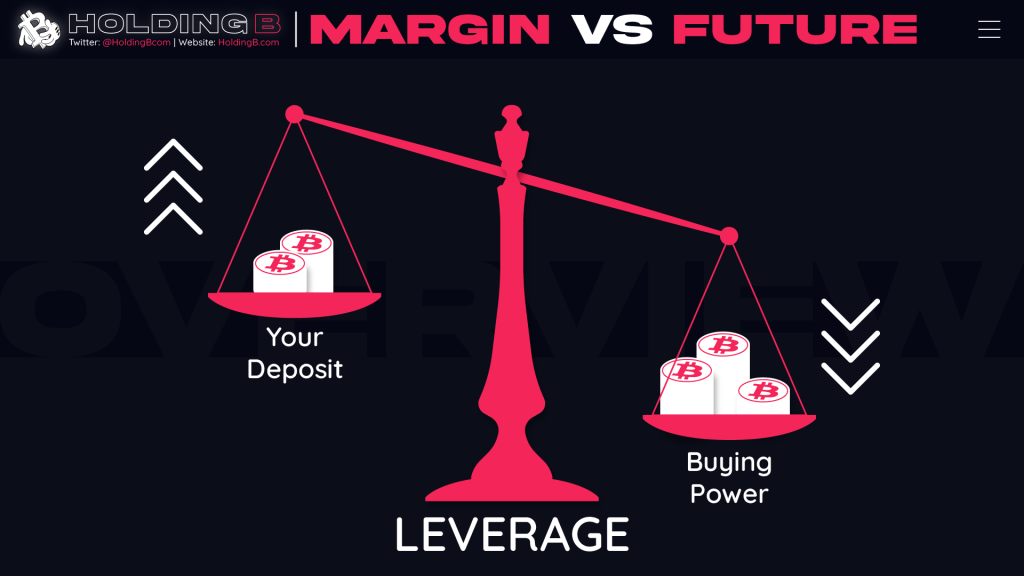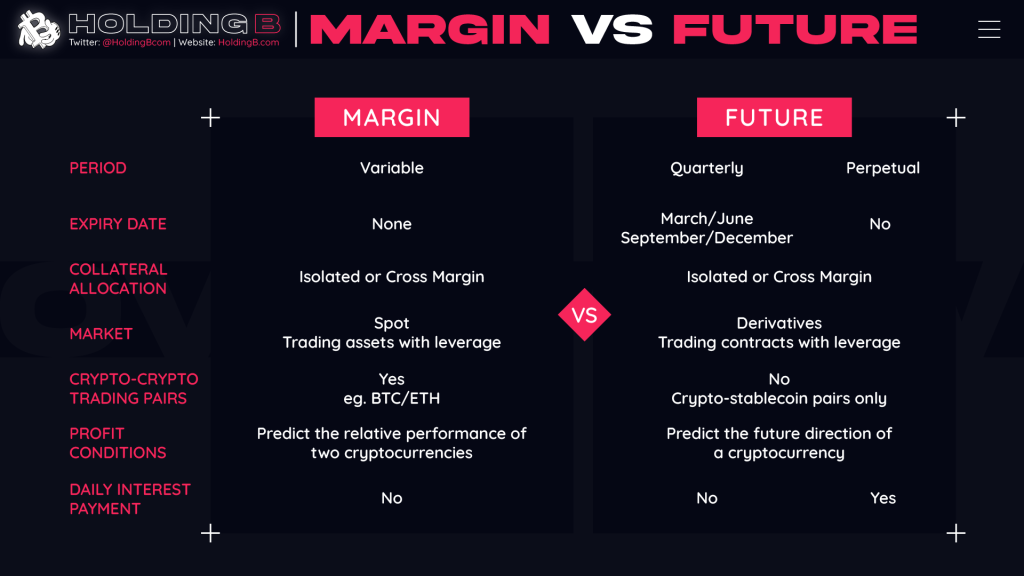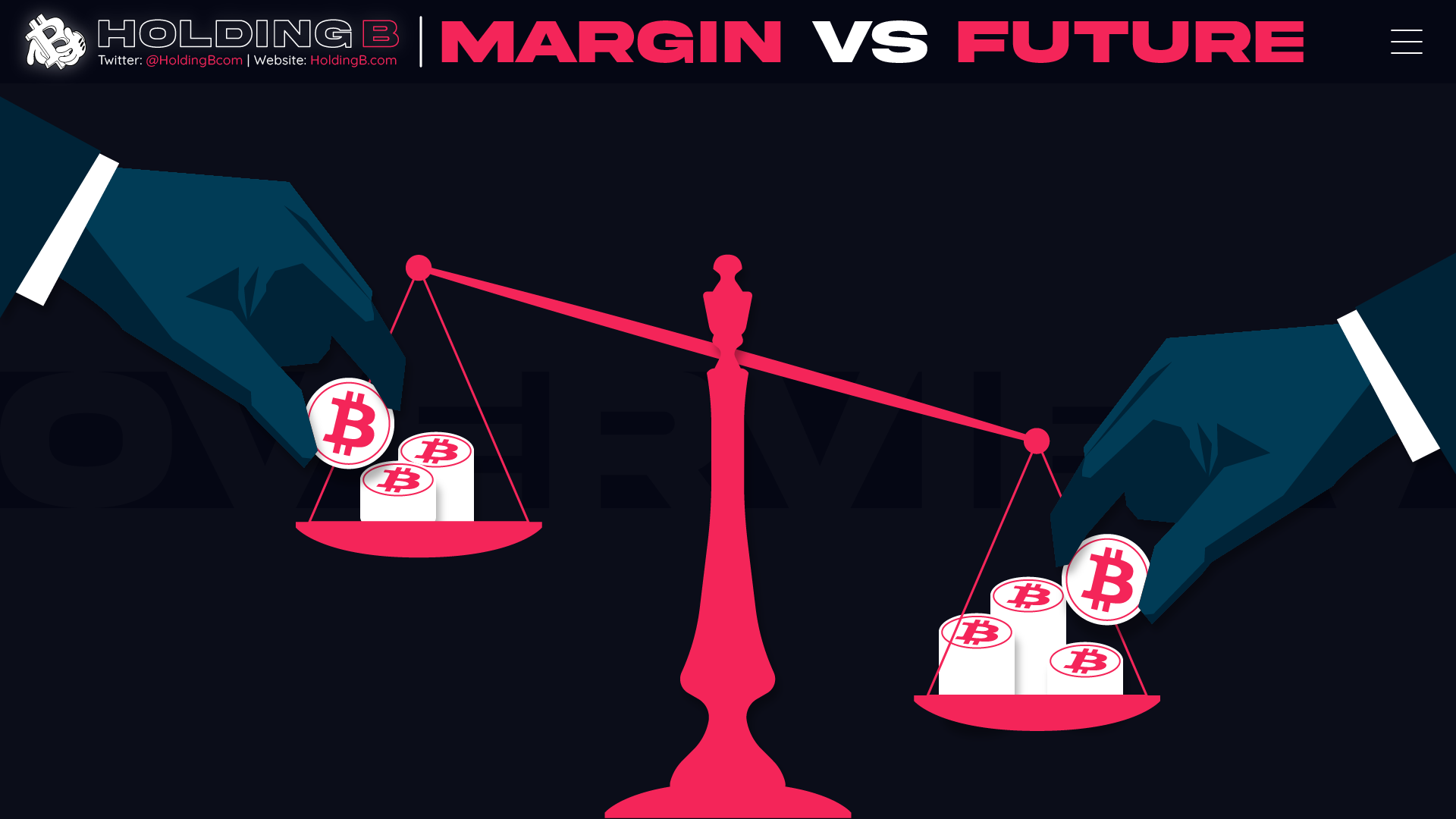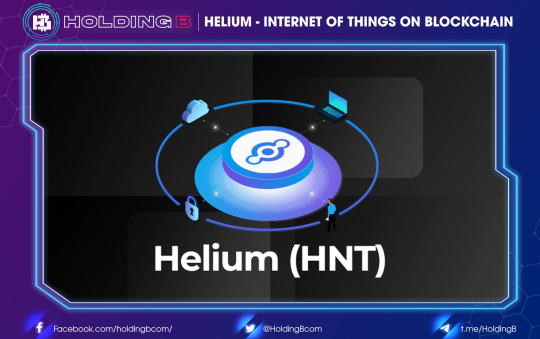MARGIN TRADING
WHAT IS MARGIN TRADING ?

Margin trading is a method of trading assets using funds provided by a third party. When compared to regular trading accounts, margin accounts allow traders to access greater sums of capital, allowing them to leverage their positions.
Essentially, margin trading amplifies trading results so that traders are able to realize larger profits on successful trades. This ability to expand trading results makes margin trading especially popular in low-volatility markets, particularly the international Forex market. Still, margin trading is also used in stock, commodity, and cryptocurrency markets.
In traditional markets, the borrowed funds are usually provided by an investment broker. In cryptocurrency trading, however, funds are often provided by other traders, who earn interest based on market demand for margin funds. Although less common, some cryptocurrency exchanges also provide margin funds to their users.
HOW DOES MARGIN TRADING WORK?
When a margin trade is initiated, the trader will be required to commit a percentage of the total order value. This initial investment is known as the margin, and it is closely related to the concept of leverage. In other words, margin trading accounts are used to create leveraged trading, and the leverage describes the ratio of borrowed funds to the margin. For example, to open a $100,000 trade at a leverage of 10:1, a trader would need to commit $10,000 of their capital.
Naturally, different trading platforms and markets offer a distinct set of rules and leverage rates. In the stock market, for example, 2:1 is a typical ratio, while futures contracts are often traded at a 15:1 leverage. In regards to Forex brokerages, margin trades are frequently leveraged at a 50:1 ratio, but 100:1 and 200:1 are also used in some cases. When it comes to cryptocurrency markets, the ratios are typically ranging from 2:1 to 100:1, and the trading community often uses the ‘x’ terminology (2x, 5x, 10x, 50x, and so forth).
Margin trading can be used to open both long and short positions. A long position reflects an assumption that the price of the asset will go up, while a short position reflects the opposite. While the margin position is open, the trader’s assets act as collateral for the borrowed funds. This is critical for traders to understand, as most brokerages reserve the right to force the sale of these assets in case the market moves against their position (above or below a certain threshold).
For instance, if a trader opens a long leveraged position, they could be margin called when the price drops significantly. A margin call occurs when a trader is required to deposit more funds into their margin account in order to reach the minimum margin trading requirements. If the trader fails to do so, their holdings are automatically liquidated to cover their losses. Typically, this occurs when the total value of all of the equities in a margin account, also known as the liquidation margin, drops below the total margin requirements of that particular exchange or broker.
MARGIN TRADING IN CRYPTOCURRENCY MARKETS

Trading on margin is inherently riskier than regular trading, but when it comes to cryptocurrencies, the risks are even higher. Owing to the high levels of volatility, typical to these markets, cryptocurrency margin traders should be especially careful. While hedging and risk management strategies may come in handy, margin trading is certainly not suitable for beginners.
Being able to analyze charts, identify trends, and determine entry and exit points won’t eliminate the risks involved with margin trading, but it may help to better anticipate risks and trade more effectively. So before leveraging their cryptocurrency trades, users are recommended first to develop a keen understanding of technical analysis and to acquire extensive spot trading experience.
ADVANTAGES AND DISADVANTAGES
Advantages
– Great Profits: Margin trading can yield larger profits due to the relatively larger value of the trading positions. This is the biggest advantage that this platform gives investors to buy and sell BTC, buy and sell ETH, buy and sell cryptocurrency.
– Diversify investments: As traders can open many positions with relatively small investments.
– Easy to open positions: Margin accounts can make it easy for traders to open positions quickly without having to transfer large sums of money to their accounts.
Disadvantages
– Vulnerable to loss: High profit means that the risk of loss is also high, therefore, if you are not alert, you can make big losses.
– High Risk: When doing margin trading, the trader can incur losses that exceed the initial investment, so it is considered a high-risk trading method.
- Note: Depending on the amount of leverage on a trade, even a small drop in the market price can cause significant losses for traders. For this reason, investors, who decide to use margin trading, need to use appropriate risk management strategies and risk reduction tools, such as stop orders. limit.
FUTURE TRADING
WHAT IS FUTURE TRADING?
Future, also known as a futures contract, is a transaction to buy/sell commodities at a certain time in the future, at a predetermined price. At that point, the buy/sell transaction must be made at a predetermined price, regardless of the price at the time.
When trading Futures, you don’t own the assets, you own the contracts, or “Contracts”. This contract is non-transferable and can only be closed prior to its expiration date.
On Binance or Bitmex, one will often choose to trade Futures with Perpetual Contracts, meaning perpetual contracts. With this type of contract, you can close it at any time, and depending on the difference in price with when you placed the order, it will calculate a profit or a loss.
In Future we also have the concept of Future Margin, that is, you will deposit an amount to borrow more money on the order, up to 100x (Bitmex) or 125x (Binance). Margin will help you maximize profit or increase risk many times (risk of account burning and loss of all deposit).
Because there is no real trading, Future Trading is a derivatives market. Prices are based on the spot market. However, sometimes there are times when the number of orders is too much liquid (because the trader does not have enough margin), the price on the Future will run faster than the spot market. On the chart, there will be very long candlesticks, sometimes going to 0, people often call it “kill margin“.
The fees charged for futures trading are Funding Rates, which cover the price difference between the derivatives market and the spot market. This fee can be positive (you pay) or negative (you get money). This fee is not fixed, changes every 8 hours depending on the balance between buy/sell orders in the market.
HOW DO FUTURES WORK?
While digital assets are met with diverse and unique challenges, from high volatility to negative publicity in some states, some traders use this volatility to their advantage.
The most vital thing to note in crypto futures trading is that you only take risks on the price changes without holding the actual cryptocurreny.
Let’s consider a simplified example. Say John and Sarah entered a Bitcoin futures position at $40,000 each. In this scenario, John has a long position while Sarah took on an opposing trade. Upon expiration, the Bitcoin futures price settled at $45,000 for each contract. In this case, Sarah, who is holding a losing position, will have to pay the exchange the deficit loss ($45,000-$40,000 = $5,000). John, on the other hand, will receive a profit of $5,000 from the exchange.
PROS & CONS OF TRADING FUTURES
Lucrative endeavors such as futures trading come with their fair share of advantages and disadvantages. Herein are the pros and cons of trading these derivatives.
Pros
– Crypto trading futures allows one to bet against the market. For example, one can profit from both rise in crypto asset value and its fall.
– Crypto futures offer leverage on capital. This is advantageous as traders can gain significant exposure to an asset with only a fraction of its total cost. Therefore, leverage trading is the most attractive aspect of futures trading.
– It allows for hedging. It is a perfect choice when it comes to hedging your portfolio.
Cons
– Volatility: The high volatility can be a blessing or a torment to traders. Determining the market’s movement is not a guarantee.
– Highly risky: Due to the high leverage involved, crypto futures is one of the riskiest trading instruments. Novice traders should minimize their exposure to futures trading and trade them with a robust risk management strategy.
HOW TO TRADE FUTURES CONTRACTS ON BINANCE?

Trading futures contracts on Binance is pretty straightforward. If you are an existing Binance user, you can get started with futures trading within minutes.
To begin:
- Open a futures trading account on Binance. Please note that you must enable a 2FA verification to fund your futures account before you start trading on Binance Futures. Read more about account opening here.
- Deposit funds in USDT, BUSD, or cryptocurrencies supported by Binance Futures. Binance Futures supports a wide range of crypto assets as collateral.
- Select your preferred futures contract. There are two types of futures contracts available on Binance: USDⓈ-M Futures and COIN-M Futures. For example, if you want to trade BTCUSDT perpetual contracts, please select USDⓈ-M Futures. For BTCUSD coin-margined contracts, select COIN-M Futures.
- Select the appropriate leverage for your futures contract.
- Place orders according to the various order types available on Binance Futures. For starters, you can select a buy-limit or buy-market order to purchase for your first futures contract.
MARGIN VS FUTURES TRADING IN BINANCE
MARGIN TRADING VS. FUTURES TRADING – WHAT’S THE DIFFERENCE?
- Trading Pairs
Margin trading offers access to exotic trading pairs. In traditional margin trading, an exotic trading pair involves two global currencies paired together (ex: AUD and CHF). Instead of buying or selling the currencies themselves, the trader is speculating on the relative performance of the two. The same goes for trading pairs with crypto, and in place of AUD/CHF, you’d find something like BTC/ETH. In this case, you are speculating the relative performance between Bitcoin and Ethereum. A thing to remember here is that the more volatile a currency is, the less liquidity the market for it generally holds. Meanwhile, futures contracts don’t offer exotic asset pairings like margin, and instead, the contracts are denominated in a single cryptocurrency or currency in general (BUSD, USDT, USD).
- Daily Interest Payments
When trading with margin or a perpetual futures contract (available on Binance), trades will incur daily expenses. Funding fees and interest payments are taken into account on all trades, every day. Daily interest expenses can add up quickly, especially when a position is held over a long period. These fees and interest payments can be avoided altogether when trading a quarterly futures contract. Quarterly contracts on Binance incur no daily interest charges or fees, making them the ideal product for long-term holders.
- Expiration
As alluded to earlier, margin trades are potentially more dependent on the careful attention of a trader, and this is because they can be traded in perpetuity, or continuously. There is no set date on which the trader agrees to close the trade. With futures contracts, and more specifically quarterly futures contracts, traders must adhere to the time frame allotted in the contract. Read our past blog post on what to expect on Futures expiration day.
- Prices –
When trading with margin, prices of cryptocurrencies pairs are similar to the spot market. In contrast, the futures price is based on its prevailing spot price plus the cost of carry during the interim before delivery, this is also known as the basis. The futures basis may fluctuate due to changes in supply and demand, causing futures prices to temporarily deviate from the spot price. This opens up opportunities for arbitrage between margin and futures contracts. For example, if the funding rate on a futures contract is negative, traders can capitalize on the price discrepancy by going short on margin and long on the perpetual futures contract.
- Markets & Trading assets
Margin Traders place orders to buy or sell cryptos in the spot market. This means that margin orders are matched with orders in the spot markets. All margin related orders are actually spot orders. While trading Futures, traders place orders to buy or sell contracts in the derivatives market. In summary, Margin and futures trading are in two different markets.
- Leverage
Margin Traders have access to 3X~10X leverage with assets provided by the platform. The leverage multiplier is based on whether you are using isolated margin or cross margin mode. In contrast, futures contracts offer higher leverage.
- The general concept of Margin and Futures of the transaction corresponds to each other, so to make it easy for you to use, you can refer to the following information:

SIMILARITIES BETWEEN MARGIN AND FUTURES
- All are margin trading, using leverage.
- It is possible to make profits both ways, when the market is up or down.
- The position can be liquidated, if the risk is too high.
- When opening a position, you can choose Cross or Isolate:
– What is Cross? With this option, it means that the position will automatically use all the balance in the Margin/Futures account to prevent account burnout. For example, if you bet $100 and your account balance has $1,000, when the position is at risk, it will automatically deduct $1,000 and the order will only be liquidated until you run out of money in your account.
– What is Isolate? Is solely responsible for the exact amount in the position. This avoids the risk of heavy loss, even loss. For example, if you open a position of $100, if you take a risk, it will only burn $100 and will not cause damage to your account balance.
ADVANTAGES – DISADVANTAGES OF USING MARGIN/FUTURES
Besides the difference between Margin and Futures on Binance, you should also learn about the pros and cons of these two forms of trading.
Advantages:
– Profits increase, multiply assets quickly, if the market trend is correctly guessed. By choosing how much leverage you choose, the profit increases by many times compared to the Spot market.
– Can diversify investment items, with the amount of capital does not need to be too large.
– Can make profit even when the market goes down (Downtrend)
Defect:
– High profit, proportional to great risk. The higher your leverage, the easier it is to get liquidated.
– Vulnerable to sharks to manipulate prices, causing accounts to be liquidated quickly. And this, people often call Kill Short / Kill Long or collectively known as Kill Margin





